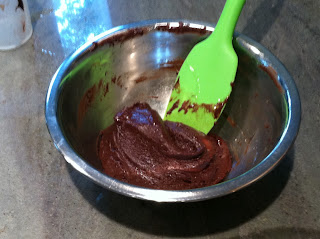 |
| The Battenberg Cake pattern |
This month's challenge is in honor of the celebration of the Jubilee, which marks the 60th anniversary of Queen Elizabeth's taking the throne. The year of 2012 has been filled with tours, celebrations, parties and events to celebrate the anniversary. The Battenberg Cake originated in the United Kingdom in the late 1800s during Queen Victoria's reign. The chefs of the British Royal Family were introduced to the German style of cake making which included the use of bright colors and marzipan. The first Battenberg cake was made in that German style to celebrate the wedding of Queen Victoria's granddaughter, Princess Victoria, to Price Louis of Battenberg. The cake is typically a light sponge, made with the use of almond flour and apricot jam.
Traditional Battenberg Cake
Servings: about 8Ingredients
¾ cup (1½ sticks) 175gm / 6 oz Unsalted Butter, softened & cut in cubes
¾ cup / 175gm / 6 oz sugar
1¼ cups / 175gm / 6 oz self-rising flour (***see end of doc on how to make your own)
3 large eggs, room temp
½ cup / 65gm/ 2 1/3 oz almond flour (or ground almonds)
3/4 tsp / 3½ gm baking powder
½ tsp / 2½ ml vanilla extract
1/4 tsp (1¼ ml) almond extract
red food color
1/3 cup (80 ml) 100gm /3 ½ oz apricot jam (I used plum buttercream)
1 cup / 225gm / 8 oz Marzipan or Chocolate Plastic (recipe to follow)
Chocolate Plastic
7 oz dark chocolate
1 1/2 oz corn syrup
Directions
1. Make the chocolate plastic by heating the chocolate in a double-boiler. When melted, remove from heat, stir in corn syrup until thickened and pulling from edges of bowl. Move to a plastic bag, seal and remove air, refrigerate for at least 2 hours.
2. Preheat oven to 350°F/180°C/160°C Fan Assisted/Gas Mark 4 and grease an 8” square baking pan.
3. Line the tin with parchment paper, creating a divide in the middle with the parchment (or foil) (see below).
(4. OR Prepare the Battenberg tin by brushing the tin with melted butter and flouring.)
5. Whisk together the dry ingredients then combine with the wet ingredients in a large bowl and beat together just until the ingredients are combined and the batter is smooth.
6. Spoon half the mixture into one side of the prepared baking pan.
7. Add a few drops of red food color to the remaining batter and stir to combine.
8. Spoon the pink batter into the other half of the prepared baking pan.
 |
| Modified 8" baking pan |
10. Bake for 25-30 minutes until the cake is well risen, springs back when lightly touched and a toothpick comes out clean (it should shrink away from the sides of the pan).
11. Leave to cool in the tin for a few minutes before turning out to cool thoroughly on a wire rack.
12. Once completely cool, trim the edges of the cake with a long serrated knife.
13. Cut each colored sponge in half lengthways so that you are left with four long strips of sponge.
14. Neaten the strips and trim as necessary so that your checkered pattern is as neat and even as possible.
15. Gently heat the apricot jam and pass through a small sieve. I defrosted some frozen plum buttercream, and beat with hand mixer.
16. Brush warmed jam onto the strips of cake to stick the cake together in a checkered pattern.
17. Dust a large flat surface with powdered sugar then roll the chocolate plastic in an oblong shape that is wide enough to cover the length of the cake and long enough to completely wrap the cake
18. Brush the top of the cake with apricot jam.
19. Place the cake on the marzipan, jam side down.
20. Brush the remaining three sides with jam.
21. Press the marzipan around the cake, making sure the join is either neatly in the one corner, or will be underneath the cake once turned over.
22. Carefully flip the cake over so that the seam is under the cake and score the top of the cake with a knife, you can also crimp the top corners with your fingers to decorate.
23. Neaten the ends of the cake and remove excess marzipan by trimming off a small bit of cake on both ends to reveal the pattern.
 |
| The finished Battenberg Cake |


No comments:
Post a Comment